NOTE: This is a messy text. I tried my best in figuring out how 3d printers will effect our environmental thinking but the subject is too complex to figure out here. The text was written in preparation (and aftermath) of a seminar discussion on Sustainable Maker Culture organized by Cindy Kohtala (Aalto University) for the WDC2012 Pavilion (18.7.12). This text is best read as a dystopian scifi fantasy.. A glimpse to the infrastructure and aesthetic mindset of todays precarity.
———————————————————————-
<prologue> When our parents die, we’ll inherit autodesk-3ds-Max 3d model project files of the things they owned. We’ll be stuck with gigabytes of .3ds_Max data on usb-sticks. When I want to sit on my granddads favorite chair.. I’ll print it, only to be remelted when I need the plastic for printing my grandmas white t-cups. Idyllically the files will be stored into a data-cloud, a heaven of a sort for our things. I’ll rely on a clergy of technocrats who maintain the data-clouds where my heritage is stored.. Our past environmental thinking was focused on glamorizing the aura of things (Aura in the sense of Walter Benjamin).. We’ve assumed that as things grow old they become more valuable and intrinsic value is added to an object as it is touched, repaired and loved. The more generations touched a thing the more valuable it became. The current culture preservation paradigm is that we should also make digital replications of all significant things. Libraries have been digitized and culture history museums are catching up. After everything is digitized; Nothing can be broken (or repaired). How will this add to our appreciation of our heritage? I seldom print family photos as I can enjoy them trough the computer screen. It’s likely that we’ll continue to enjoy the 3d-models of their parents chairs on screens too. Or render them into virtual worlds like Second Life and Minecraft; instead of actually manufacturing them. (Recommended audio while reading)</prologue>
I found a Kickstarter.com project in the “conceptual art” category which takes us back to Joseph Kosuth. Pennsylvanian artist Asheley Zelinskie is planning to re-imagine Kosuths “One and Three Chairs” piece (1965). Her project is called “Reverse Abstraction”. The upcoming chair she’ll produce consists of raw data extracted from a 3d-model of the chair seen on “One and Three Chairs”. The work will be called “One and One Chair”. Let’s break that down..
- A. She made a 3d-model of Kosuth chair based on photographic representations.
- B. She’ll take the “binary and hexadecimal code” of the 3d model project file and use this text as a pattern when printing the chair. (The pattern is the structural element).
- C. “There will be nothing to the chair but the numbers that make up the chair.”
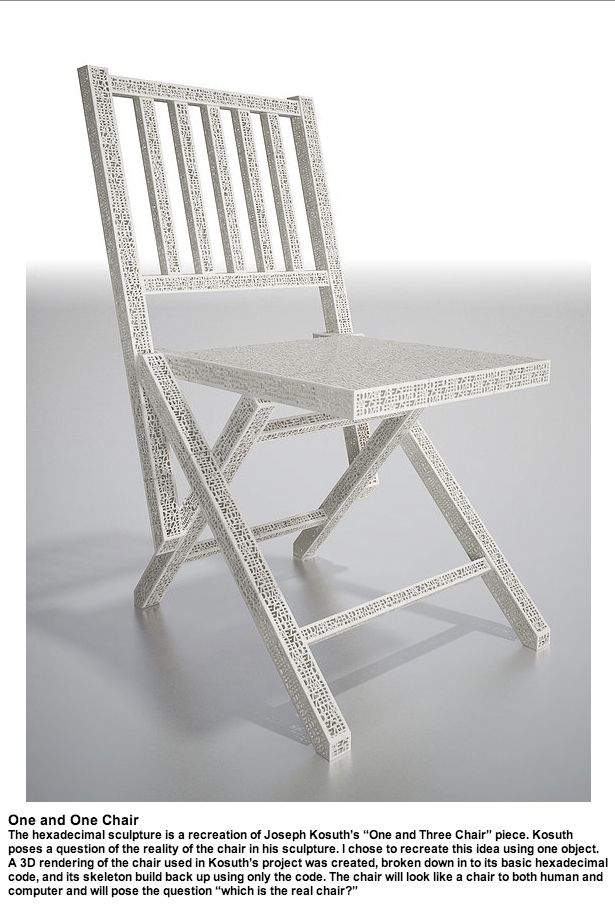
The image here is a concept illustration. The finished chair will look something like this.
The project is already on it’s way and first drafts using a “Replicator Bot” 3D printer have been made. Zelinskie is hoping to “further his [Kosuth’s] commentary by pushing it into the context of the 21st century”. It is an artwork for computers. Humans will see her chair as an abstraction but computers will see it as a chair. (As computers may rebuild the original image from the code). This sounds complicated but it’s pretty simple.. We are are confronted with similar processes daily with things like HTML and qr codes. Computers render a reality (or augment it if we so choose).

“Render a Chair in Leet” (Ore.e Ref. NCD-C 2012)
Our experience of reality is being augmented with technical aids and synthetic realities are born from algorithms as we speak. 3d printers are turning design and crafts into hyper-textual, dynamic processes; dependent on automated smart-systems to produce things. These processes are so complex that they mimic nature as individuals are incapable of understanding how the systems work. Language has always effected our view reality but now we are faced with synthetic realities, which deploy their own formal languages. We can no longer separate synthetic nature from the real. Our “bot” friends on twitter are in the same category as “natural” friends..
In the 3d printer/maker utopia production is not controlled by the maker or the markets s/he builds but by the algorithms which determine which designs are most popular (on online 3d model sharing sites) and customization algorithms which merge design patterns together. According to the utopia everything will be customized and produced ON-DEMAND. 3d printer lobbyist portray this as a change for the better as localized manufacturing and related customization/ON-DEMAND design processes resemble “the golden days of crafts”, when only things which where really needed where produced. But everything in the upcoming scenario differs from the times when village smiths made things which the surrounding communities needed on-demand.. Customization and ON-DEMAND design only mimic this ideal.
In “the golden times” a communities relationship to it’s environment build norms which defined what was important enough to be produced. The labor time of the smith was more valuable then the artistic quality of the design. The needs of the community helped to map the projects which labor time was divided to. It was a system of honor.. Craftspeople refused to produce nonsense stuff (as self respecting ones still do).
What we will consume in the future will not be affected by a relationship to our environment (community or nature). We will have better control of how our environment appears to us but less of a relationship to it. In the past we needed to form relationship with a maker to have things produced. In the future: Production does not require a relationship to anyone. We live with things (like this computer) which are exact copies of each others and we are loosing our cultural context as objects (which convey memories, emotion and a sense of history) we live with are mass-produced, re-mediated to digital versions and owned by a multitude of people simultaneously in synthetic and RL worlds. We fell empty being surrounded with mere replicas and pursuit for real experiences. 3d printers result into loneliness. We are entering an era of self-inflicted industrial loneliness.
There will be even more knowledge and information to consume and even less need for communication.

Only Morpheus can disagree.
What we own defines us. The things we inherit (and don’t inherit) echo our socio-economical class and history. In our fear of being defined by the past we have chosen to eradicate traces of it. Yesterday we preferred being called by our first names – Not with our family names (war-traumas) and surrounded our selfs with mass produced goods.. Today even cheesy white tee cups appear to define us too much. The act of owning is too much! In lines of the 3d printer/maker utopia, we are plotting to immerse ourselves with things that can be melted and re-printed to something different on a daily basis or reconfigure and personalized with a push of a button. Everything is in a flux or synthetic/virtual, at home and at work..
Our working spaces have turned into collective hubs (link to video) and the workers computer operating systems are fitted on personal bootable usb-sticks. This stick includes everything a worker of today requires. Any device with an usb-port or sd-card slot and access to internet will enable him to work. The infrastructure of the precarity is modular and technological formats unified. First off this seems like a positive change.. The sales speech here is that less electronic waste is produced when we share our computers and computer systems work in an unified ecosystem.. But a dependency to a corporation controlled cloud service and formats, is a hard price to pay and we’ll still waste the resources of the world by shopping electronics targeted for our leisure time. In the future we’ll own crappy hardware and be dependent on anonymous specialists (working in the data clouds) good will; to grant us processing power. Generalist are dependent on infrastructure build by invisible specialists. It’s been a dream for a while now that workers should own their factories. Owning a personal computer is nearly as good as owning a factory for text. (The subject of precarity is expailed in detail in essay ‘Time-wars’ by Mark Fisher).
There is nothing to be gained in forming a definitive relationship to things one owns. We consume experiences, because experiences are real. Vanilla operating systems give the most authentic experience. We will reset an object by printing a new one; Things will never age, there is no fear of death. Prints of things crumble but the designs will exist forever as virtual models. We will be offered updates to everything from furniture to programs. Most of these will only change the appearance of things – More importantly these updates will remind us that everything is in flux and that attachment to things is futile.
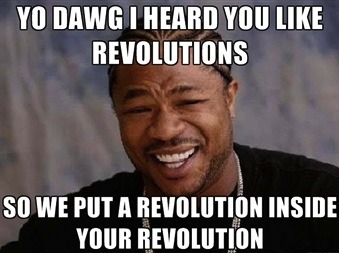
In the past people inherited their parents tools when they reached adulthood and mastery in their craft.. When they proofed them selfs worthy, as good as their parents where they where honored with the responsibility of using the tools their parents wielded. Now we are stuck in a cycle rapidly prototyped revolutions. Every tool made is a revolutionary innovation and to make way for innovation, old tools need to be trashed. (When I talk about tools here I mean white t-cups, power drills, cooking-ware and laptops.)
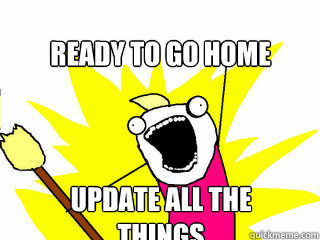
People do not like handmade things anymore because acquiring a handmade thing establishes a visible dependency to the other. The process of owning something is an active partnership and a responsibility. It’s always a burden to own things which are realized by an individual. Thought our appreciation of the things which surround us we are appreciating labor and laborers who produced them. The more labor spend in the production of something the more valuable it becomes. Human effort and struggle is immersed in PROPER HANDMADE DESIGN, handmade things are tragic. We fear this laborer, because we feel inferior to her/him and have excluded them from our private spheres. We have chosen to own things which (seemingly) have required less labor to produce and are hense are less stressful to neglect, waste and update.
I’ve been taught to “love my work”.. Which means I see work as a form of prayer (I aspire for perfection when working as a carpenter; in hopes of reaching out to the other). From this perspective 3d printers and generally all processes which produce stuff effortlessly: Discredit “the maker”. Such processes do not celebrate the process of making. I’m pretty sure that monks and other craftspeople who worked to copy manuscripts felt the same sort of anger when printing press tech was introduced. (They call it the Makerbot! A maker in a shell. What has the Pope to say about that?!)
It’s often argued that the development of printing press technologies with movable type by Gutenberg, were motivated by an humanitarian effort of educating the general public by making written knowledge more accessible. It can be said that the mass production of books was an important development step towards the era of enlightenment. Printing tech had an impact in the Protestant reformation movement as Martin Luther’s 95 Theses were printed to be circulated widely.. Also printed bibles which Gutenberg produced where a little cheaper then hand copied ones and the most sold items from his printshop where grammar books. In theory more people gained broader access to written information thanks to the arrival of the printing press. 3d printer lobbyists, the maker boom and different sorts of online open source development projects originate and continue this reformist heritage. It would be interesting to study in what kind of a relation the printing press technology, protestant reformation and the idea General Intellect drafted by Karl Marx have to each other. On thing is for sure.. The selling of printed books is more profitable then selling hand made manuscripts and selling Makezine and similar diy’s magazines is financially more profitable then attempting to sell things these magazines teach people to make. Many can make a living from lobbying p2p-production ideology but only few can make a living making things in a p2p-production scheme.
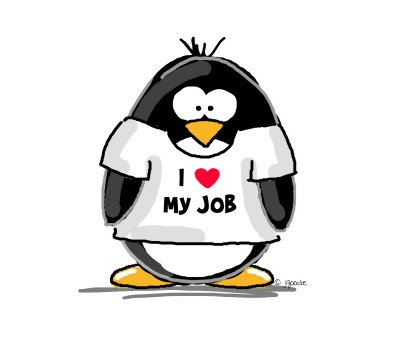
In a postfordian society a worker is not compensated for the hours s/he spends working. A worker must do the majority of her/his work unpaid, during leisure time. Workers spend their wake hours self-educating and developing potentially innovative products, services and methods of system optimization (updates). These innovations (and knowledge gained trough self-education) are intended to be sold for the networks of corporations the worker is connected to. Companies still need employees, but they have outsourced the development of their businesses – To the employees and to consumers by crowdsourcing. There are huge risks in any creative effort. As workers (and corporations) are seeking out the most risk free methods of advancing in their careers (or making profit), they soon discover that profit is most easily made by managing and curating existing information. By creating systems which merely manage information collected by crowdsourcing.. By copying systems which have made most profit in other venues.. By making duplicates of “classics” or copying someone else’s style of work. Creativity is a trial and error process but corporations seeking profit cannot tolerate failure. Hense we’ve have entered an era of COPY-PASTE Economy. For example blogs and news sites get their revenue from copy-pasting relevant information, made by others but are seldom required (by the markets) to produce new content them selfs. In the blogosphere we are getting close to a “Post-Scarcity Economy”. Explained in an easygoing manner here (youtube).
3d printers serve this utopia well as they are most suitable for rapid prototyping. For making stuff in hopes that it will sell. Today, design (processes which transcribe ideas into tangible objects) can be copy-pasted too..
Our past environmental thinking was dependent on our understanding of a causality: If a thing is produced it exists forever. Things are things despite their context. There is no ‘trash’ only materials which we have neglected. Computer oriented design and 3d printers alter this understanding. An ‘object’ is more real in it’s native synthetic reality: Inside the computer. And there is no trash in the synthetic worlds (We made them so). Printing a 3d model displaces it form it’s native synthetic environment.
René Magritte was wrong with the “The Treachery of Images”: IT IS A PIPE!!1
Previously we have been capable of copy-pasting only text and images.. Ultimately the context something was “pasted to” defined what the text or image meant. As 3d printed things are decontextualized by default, we’ll have the opportunity to manufacture things which are totally contextless! We’ll produce only prototypes. Where does contextless design fit? It’s not the same process as in inventing new words; As uttering the the word ‘chair’ will not print a chair to the world. Code can have a causal effect to it’s environment.. Where as words like “kissinseah” can go on with out having absolutely no impact on the world and waste very little resources.

We now have the possibility to replicate a 1:1 low-fi-paradise as we personally imagine it, using affordable equipment at our homes. Futures realities will not be merely augmented with gf-rendering goggles, they will be manufactured with printers as we speak.. (umhh.. write.. I mean draw). A 3d printed object is a tangible copy of it’s virtual self: It is not individual. This is why Zelinskie is calling her upcoming sculpture “One and One Chair”. We see the difference between a tangible chair and the code it’s made from, but the computers and algorithms interpreting the data do not. As we have become dependent on technology/automation to manage and curate, augment our view of the reality: We cannot care if something is real or not. Our capability to care of our environment deteriorates both in mass- and 3d printer manufacture processes.
Previously the realization of a design was a celebration of the design. Building something was an act of caring. As builders are human they most often make mistakes. New knowledge is produced from these failures. Potential failure enriched the design.. LABOR IS A CONTEXT where things became valuable. Labor builds a narrative to the design. A computer cannot fail. It only does what it’s programmed to do. As a computer cannot make mistakes; It cannot succeed in realizing anything. I does not tell a story. Something unexpected might occur due to glitches but glitches only mimic nature as all glitches are domesticated. There is no utterance in code. (The field of glitches are explained in detail in the “GltchLnguistx: The Machine in the Ghost / Static Trapped in Mouths” article). As no intrinsic value is passed to the object because it has not become real as a result of labor. Also, there is no room for “intentional mistakes” in the computer orientated making process – Producing such is a duty of any maker interested in sustainable design!
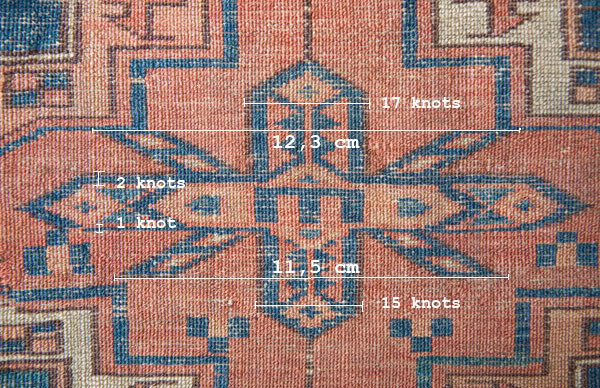
Image via: http://www.turkotek.com/
It’s known that Persian matt weavers created intentional mistakes as a standard action so as not to offend their creator. The reasoning for this gesture was that only god was capable of perfection in creativity. This is a great tradition and has been turned into a style of surface finishing. It is called “the rustic appeal" (dictionary) and inflicted patina (the market value of which is illustrated well in this etsy.com video: ”Classic Wrecks: The Rusted Car as Art“). It means that authentic handmade stuff is expected to look a crappy, rusty and worn.. It’s expected to look different (often inferior) to machine produced goods. This aesthetic canon (enforced for the glamorization of modernization) is forcing craftspeople around the globe to hide their skills.
Truth be told: 100% Hand made things can look as cool, perfect and "clean” as mechanically produced goods do. In fact it’s always been a ideal of a skilled craftspersons to make things so perfect, that there is very little of the makers persona present in the object. The best sort of crafts look as if they are made by no-wo/man. They looks as if it has not been touched by a mortals and are unique.

“Between the Warehouses with Ashley Zelinskie” Image via: http://bushwickdaily.com/
The other head of the NO-CHAIR-DESIGN campaign Jesse Sipola has been pointing on the vanity of 3d printers since these became popular with tinkers. He’s statement is “3d printers are the bread machines of today.”. This is a clever statement.. If bread machines would be introduced today they would possibly be called “Organic Nutrient Replicators”. They where popular in the ‘90ties but as they took the fun out of backing, they are currently stored in the garages. Bread machines will remain unused until they’ll catch enough patina to be considered vintage by collectors or smaller muffin machines which run on usb-power will be introduced for geeks.
Jesse is a blacksmith but he is not content with the definition of blacksmiths being “traditional craftspersons”. He sees his craft as a contemporary method of manufacturing; Not as a live-action-roleplay show suited for rural town fairs. He’s craft is not a representation of the “golden old times”, it’s a contemporary practice. Anything you need manufactured from metal you can ask a blacksmith of today to build. He’s not categorically against them but heavily critical of the hype around them which makerbot and other maker culture initiatives and companies have stirred. The ideal these companies are portraying is, that in the future designers will manufacture their products by printing them on-demand in their home offices.. This way they’ll be able to compete against oversees mass production and enhance our appreciation of the things we own (as we see how they are made). Jesse argues that this is nonsense.
Artisans of to day produce items on-demand for cheep too but people still prefer mass produced goods. 3d printers only escalate problems.
———————————————————————-
This text focuses on the negative aspects of the 3d printer/maker boom but is not intended to be a turnoff for future collaborations between makers and craftspeople. There is huge potential in hacklabs, hubs and autonomous maker-spaces emerging in our city centers. The idea of building crafts-enabling shared workspaces in urban centers is also a dream for many craft-specialist. Crafts culture is marginalized as development orientated city planners have pushed most of metal- and woodworkers into rural areas. A bridge between the maker- and craft cultures should be build.
EDIT: A similar idea of “industrial loneliness” is found in a manifesto of the “SPECIAL #FFF EDITION – ANONYMOUS” information leak: “We are not the real owners of anything anymore. We just borrow things from the System. Shiny, colorful things, we agree to play with for a fee. A fee for life. […] Your home, stuff, car and computer, you will pay for everything you have for all of your life. All the time: A monthly fee, forever until you die. That’s the future; nothing is really yours. LAAS – Life As A Service. You will rent your life. […] And better hurry up and work all day if you want to stay alive. Work ’til you’re exhausted and don’t think. No – thinking is bad. Play games instead, do drugs too, why not? Or go to the movies. […] Accept the offer, it’s the perfect deal.”
Recources in English: Additive manufacturing as global redesigning of politics?
Recources in English (subtitles): “Jesse Sipola, Seppä | Blacksmith (2011)” (https://vimeo.com/32786485) (video)
Resources in English: “Interview of Ukrainian Blacksmith Bodgan Popov” (https://vimeo.com/15420921) (video)
Resources in Finnish: “General intellect – Yhteinen äly ja yhteistyö tuotantovoimina”

